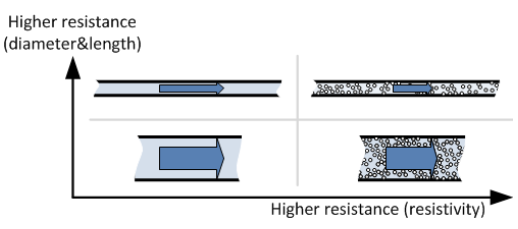Position:Home » Technical Articles
Resistors' electrical resistivity
Writer:Microhm Page View:Date:2019-06-03
Resistors' one important parameter is electrical resistivity which is a measure of a material’s property to oppose the flow of electric current. This is expressed in Ohm-meters (Ω⋅m). The symbol of resistivity is usually the Greek letter ρ (rho). A high resistivity means that a material does not conduct well electric charge.

Electrical resistance is expressed in Ohms, and is not the same as resistivity. While resistivity is a material property, resistance is the property of an object. The electrical resistance of a resistor is determined by the combination of the shape and the resistivity of the material. For example, a wirewound resistor with a long, thick wire has a higher resistance then with a shorter and thinner wire. A wirewound resistor made from a material with high resistivity has a higher resistance value then one with a low resistivity. An analogy with a hydraulic system can be made, where water is pumped through a pipe. The longer and thinner the pipe, the higher the resistance will be. A pipe full with sand will resist the flow of water more than a without sand (resistivity property).

The resistivity of a material is dependent on the temperature and is normally given for room temperature (20°C). The change in resistivity as a result of temperature change is described by the temperature coefficient. For example thermistors make use of this property to measure temperature. On the other hand, in precision electronics this is usually an unwanted effect. Metal foil resistors have excellent properties for temperature stability. This is reached not only by the low resistivity of the material, but also by the mechanical design of the component.

Electrical resistance is expressed in Ohms, and is not the same as resistivity. While resistivity is a material property, resistance is the property of an object. The electrical resistance of a resistor is determined by the combination of the shape and the resistivity of the material. For example, a wirewound resistor with a long, thick wire has a higher resistance then with a shorter and thinner wire. A wirewound resistor made from a material with high resistivity has a higher resistance value then one with a low resistivity. An analogy with a hydraulic system can be made, where water is pumped through a pipe. The longer and thinner the pipe, the higher the resistance will be. A pipe full with sand will resist the flow of water more than a without sand (resistivity property).

The resistivity of a material is dependent on the temperature and is normally given for room temperature (20°C). The change in resistivity as a result of temperature change is described by the temperature coefficient. For example thermistors make use of this property to measure temperature. On the other hand, in precision electronics this is usually an unwanted effect. Metal foil resistors have excellent properties for temperature stability. This is reached not only by the low resistivity of the material, but also by the mechanical design of the component.
Keywords:resistors
Latest News
- Resistor's role in measuring and correcting LED,,,
- Single through-hole resistors' characteristics ,,,
- Why shunt resistors for current sense applicati,,,
- Metal-film resistors with small size, high resi,,,
- 36W High-Current Shunt Resistors MMS8420,,,
- 1W Surface Mount Resistor MPR1206,,,
- An Overview of Microhm Electronics' Resistor Pr,,,
- More anti-sulfur resistors used in harsh envir,,,
- Resistance changes with temperature,,,
- 140W TO247 High Power Heatsinkable Resistor,,,
- MMS5930 is ideal for current sensing in industr,,,
- Shunt resistors selection for engineers' design,,,
- Considerations for choosing precision resistors,,,
- Ceramic Encased Cement Resistors NWH Series for,,,
- Resistors for Passive Balancing in Battery-Pow,,,
Hot Articles
- Microhm will take part in 10th Automotive World,,,
- Thanks for Visiting Microhm's Booth E5-5706 in ,,,
- Resistors in Short Supply: Blame Cars,,,
- New lunch: High Power Precision Shunt Resistor,,,,
- How to Test a Resistor,,,
- Innovative Technology, Future Electric: Electri,,,
- What is Precision Resistors?,,,
- SMD Resistors Sizes and Packages,,,
- The Construction and Features of Metal Film Res,,,
- What is a TO-220 Resisor?,,,
- Hot Selling Products: Precision Shunt Resistors,,,
- How to Calculate the Equivalent Resistance Valu,,,
- What is a Fixed Resistor?,,,
- Resistors in LED Circuits,,,
- Resistors Types and Materials Overview,,,
Resistance applications
- Miniature future for passive electronic compone,,,
- The Measurement Accuracy of Automotive Shunt is,,,
- Select the Right Resistor for Harmonic Filterin,,,
- BMS for New Energy Vehicle,,,
- Precision Resistors' Construction and TCR,,,
- Urbanization Development Bringing the Transform,,,
- Carbon Film Resistors' Features and Application,,,
- The Four Important Functions of Alloy Resistors,,,
- Industrial Roberts Applied to Solar Photovoltai,,,
- Difference Between High Precision Resistors and,,,
- Why Zero-Ohm Resistors?,,,
- Shunt Resistor MMS8420 for High Current Stable ,,,
- Surface Mount Resistor's Size and Package ,,,
- The Main Application for High Precision and Low,,,
- Heater Blower Motor Resistor in Air Conditioner,,,
